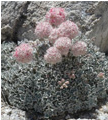Eriogonum ovalifolium var. vineum, a dicot, is a low, densely-matted perennial herb of the buckwheat family (Polygonaceae). It occurs within openings of pinyon woodland, pinyon-juniper woodland, Joshua tree woodland, and blackbush scrub communities between 4,600 and 7,900 feet in elevation on limestone or other carbonate substrates in the San Bernardino Mountains.
The flowers are whitish-cream, darkening to a reddish or purple color with age, and are borne on flowering stalks reaching four inches in height. The leaves are 0.3 to 0.6 inches long, round to ovate, and white-woolly on both surfaces. The diameter of mats is typically 6 to 10 inches, but they may reach up to 20 inches.
Cushenbury buckwheat occurs with an approximately 25-mile-long “belt ” of carbonate soils that occur along the northern edge of the San Bernardino Mountains from the White Knob area east to Rattlesnake Canyon, north and east of Big Bear Lake. Cushenbury buckwheat occurs in Arctic and Cushenbury canyons, Terrace and Jacoby springs, along Nelson Ridge, and near Onyx Peak. There is currently about 1,213 acres (491 hectares) of occupied habitat for this species.
Close to 75 percent of the Cushenbury buckwheat plants known to exist occupy habitat under claim for mining, or in private ownership and subject to mining, or on land that is threatened by other disturbances.
Because it exists in such a long but narrow swathe of land in the mountains, it is also threatened by off-highway vehicle use, a hydroelectric project, and a 115-kilovolt powerline proposed for construction through Cushenbury Canyon, dispersed target shooting, dispersed camping areas, fuelwood collection, and fire suppression activities and artificial lighting. These activities can result in trampling of Cushenbury buckwheat and impact its habitat through ground disturbance or dust creation. Artificial lighting may affect Cushenbury buckwheat’s growing conditions by altering the photoperiod response or the behavior of pollinators or seed dispersers.
Three other varieties of Eriogonum ovalifolium are distinguished from Eriogonum ovalifolium var. vineum on the basis of floral and leaf characteristics, but none occur in the San Bernardino Mountains.
Botanists believe that the Eriogonum ovalifolium var. vineum is in a middle range in its progression toward extinction in that the subspecies faces a high degree of threat but also a high potential for recovery. Its continued existence conflicts with construction or other development projects or other forms of economic activity. It is also salvageable as a species because human intercession in keeping it alive in the past has worked. Two botanists, O. Mistretta and and S.D. White introduced Cushenbury buckwheat onto a disturbed site in 1991 and 1992 and irrigated the plants. They found that about 77 percent of the individuals survived until 1998 and estimated the average half-life of the plant to be 20 years. Cushenbury buckwheat successfully reproduced and progeny were found within 6.6 feet of the planting.
Shortly after it was listed as endangered, a 1994 survey of the area in which it grows found a total of some 13,000 individual Cushenbury buckwheat plants. Of those, roughly a fourth of them – something like 3,250 – were in closely located groupings of 1,000 plants or more. In total, there were fewer than 20 places where groupings of any number of Cushenbury buckwheat occurred at all. These were scattered throughout the eastern half of the carbonate belt. The San Bernardino National Forest has since it was listed as endangered mapped 239 site-specific occurrences of this species. However, what constitutes an “occurrence” has been haphazardly defined over the various surveys, making it is difficult to specify the change in the abundance of Cushenbury buckwheat since listing. According to the U.S. Fish and Wildlife Service, the increase in the effort to survey for the plant since its listing has resulted in an increase in the number of occurrences detected and may not actually mean that there has been an actual increase in abundance.
SBCSentinel
News of note from around the largest county in the lower 48 states.

